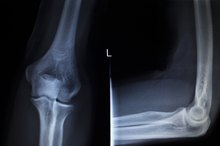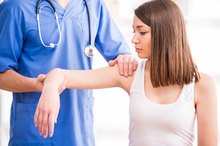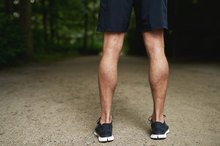Bicep Muscle Strain
The biceps muscle is on the front part of the upper arm. The muscle is attached to the elbow and at two places in the shoulder. Inflammation of the long tendon, which runs over the top of the upper arm and attaches to the top of the shoulder blade, is fairly common for athletes.
Causes/Prevention
You can strain your biceps muscle in several ways. Extended use of the biceps muscle or tendons, extreme force applied to the muscle or extreme contraction of the triceps muscle can cause you to strain your biceps. Several risk factors also exist. People who participate in contact sports, throwing sports and weight lifting are more likely to strain their biceps, as are people with poor circulation, poor nutrition, previous upper-arm injuries and poor muscle conditioning. Warming up before physical activity and participating in a strengthening and conditioning program can help you prevent a strained muscle.
- You can strain your biceps muscle in several ways.
- Warming up before physical activity and participating in a strengthening and conditioning program can help you prevent a strained muscle.
Types
Torn Tendons & Ligaments From Hyperextension
Learn More
Biceps strains are defined by their range of severity. A grade 1 strain is a minor overstretching or pulling of the biceps muscle or tendon. Such a strain involves no tearing of muscle or tendon fibers and results in no loss of strength. A grade 2 strain causes moderate tearing of the biceps muscle or tendon and may result in some loss of strength. A grade 3 strain is a severe or complete rupture of the biceps muscle or tendon and may require surgical repair.
- Biceps strains are defined by their range of severity.
- A grade 2 strain causes moderate tearing of the biceps muscle or tendon and may result in some loss of strength.
Symptoms
Symptoms of a biceps strain include pain at the front of the shoulder, when pressing in on the tendon at the front of the shoulder and when moving your arm. Muscle spasms, swelling and loss of strength also may occur, depending on the severity of the strain.
Treatment
Signs & Symptoms of a Strained Sternocleidomastoid Muscle
Learn More
Treatment usually includes applying ice or heat, taking anti-inflammatory medication or injections and performing rehabilitation exercises. The type of treatment depends on several factors, including age and severity of injury. In severe cases, surgery may be required.
Recovery
Recovery time also depends on age, health, severity of injury and injury history. While a mild strain may only take a few days to heal, a more severe injury can take up to 10 weeks. Avoid doing any activities that cause pain, except for physical therapy prescribed by your health-care provider, until you are fully recovered. In most cases, a strain will not cause prolonged disability, but in severe cases, it can cause proneness to injury or prolonged disability.
- Recovery time also depends on age, health, severity of injury and injury history.
- In most cases, a strain will not cause prolonged disability, but in severe cases, it can cause proneness to injury or prolonged disability.
Related Articles
References
- Sports Injury Clinic: Biceps Inflammation
- Summit Medical Group: Biceps Tendonitis and Strain
- American Academy of Orthopaedic Surgeons. Biceps Tendon Tear at the Elbow. Updated February 2016.
- Guo S. Delayed surgical treatment of distal biceps tendon rupture - a case report. Trauma Mon. 2012;17(3):358–360. doi:10.5812/traumamon.7146
- Sutton KM, Dodds SD, Ahmad CS, Sethi PM. Surgical treatment of distal biceps rupture. J Am Acad Orthop Surg. 2010;18(3):139-48. doi:10.5435/00124635-201003000-00003
Resources
Writer Bio
Bradley Cohen has been writing since 2006. He is the former sports editor of the "Ketchikan Daily News" in Alaska, and has been published in several newspapers and "Sports Illustrated." Cohen earned a Bachelor of Science in journalism from the University of Colorado at Boulder.








